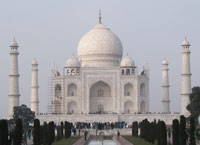 |
| Home Send Money to India Modes of money transfer India BPO India Tourism Taj Mahal Kumarakom Lakes Jaipur Pink city Alappuzha Backwaters Goa Tourism Munnar Hill Station India States Andhra Pradesh Assam Bihar Chattisgarh Goa Gujarat Haryana Himachal Pradesh Jammu and Kashmir Jharkhand Karnataka Kerala Madhya Pradesh Maharashtra Manipur Meghalaya Mizoram Nagaland Punjab Rajasthan Sikkim Tamil Nadu Orissa Tripura Uttar Pradesh Uttaranchal West Bengal India Quick Links Indiaweblinks World Wonders Web 123 Biotech Honeymoon Packages |
India States - Sikkim  Sikkim is a landlocked Indian state nestled in the Himalayas. It is the least populous state in India, and the second smallest in area after Goa. Sikkim was an independent state ruled by the Chogyal monarchy until 1975, when a controversial referendum to make it India's twenty-second state succeeded. The thumb-shaped state borders Nepal in the west, the TibetPeople's Republic of China to the north and east, and Bhutan in the south-east. The Indian state of West Bengal borders Sikkim to its south. The official language is English, Bhutia,Nepali,Lepcha, and Limboo. It must be noted though that almost all written transactions is in English. The predominant religions are Hinduism and Vajrayana Buddhism. Gangtok is the capital and largest town.Despite its tiny size, Sikkim is geographically diverse, owing to its location on the Himalayas. Terrain ranges from tropical in the south to tundra in the north. Kanchenjunga, the world's third highest peak, is located in Sikkim, straddling its northern border with Nepal. Sikkim has become one of India's most visited states owing to its reputation of cleanliness, scenic beauty and political stability. It's Geography is dominated by the most majestic mountain chain in the world which includes the Khangchendzonga.The magical lure of Sikkim has always been attracting people all over the world. Its legendry mountains, landscape that defy imagination, all culminates into a masterpiece of the Creator. But you don't have to be the holy one to taste the beauty of Sikkim. Presently, Sikkim has thrown up its gates to every interested visitor. Browse below for all the necessary information, for both domestic tourist and foreigners.
Sikkim is a landlocked Indian state nestled in the Himalayas. It is the least populous state in India, and the second smallest in area after Goa. Sikkim was an independent state ruled by the Chogyal monarchy until 1975, when a controversial referendum to make it India's twenty-second state succeeded. The thumb-shaped state borders Nepal in the west, the TibetPeople's Republic of China to the north and east, and Bhutan in the south-east. The Indian state of West Bengal borders Sikkim to its south. The official language is English, Bhutia,Nepali,Lepcha, and Limboo. It must be noted though that almost all written transactions is in English. The predominant religions are Hinduism and Vajrayana Buddhism. Gangtok is the capital and largest town.Despite its tiny size, Sikkim is geographically diverse, owing to its location on the Himalayas. Terrain ranges from tropical in the south to tundra in the north. Kanchenjunga, the world's third highest peak, is located in Sikkim, straddling its northern border with Nepal. Sikkim has become one of India's most visited states owing to its reputation of cleanliness, scenic beauty and political stability. It's Geography is dominated by the most majestic mountain chain in the world which includes the Khangchendzonga.The magical lure of Sikkim has always been attracting people all over the world. Its legendry mountains, landscape that defy imagination, all culminates into a masterpiece of the Creator. But you don't have to be the holy one to taste the beauty of Sikkim. Presently, Sikkim has thrown up its gates to every interested visitor. Browse below for all the necessary information, for both domestic tourist and foreigners.
Sikkim is situated in an ecological hotspot of the lower Himalayas, one of only three among the Ecoregions of India. The forested regions of the state exhibit a diverse range of fauna and flora. Owing to its altitudinal gradiation, the state has a wide variety of plants, from tropical to temperate to alpine and tundra, and is perhaps one of the few regions to exhibit such a diversity within such a small area.The flora of Sikkim includes the rhododendron, the state tree, with a huge range of species occurring from subtropical to alpine regions. Orchids, figs, laurel, bananas, sal trees and bamboo in the lower altitudes of Sikkim, which enjoy a sub-tropical type climate. In the temperate elevations above 1,500 metres, oaks, chestnuts, maples, birchs, alders, and magnolias grow in large numbers. The alpine type vegetation includes juniper, pine, firs, cypresses and rhododendrons, and is typically found between an altitude of 3,500 metres to 5,000 m. Sikkim boasts around 5,000 flowering plants, 515 rare orchids, 60 primulas species, 36 rhododendrons species, 11 oaks varieties, 23 bamboos varieties, 16 conifer species, 362 types of ferns and ferns allies, 8 tree ferns, and over 424 medicinal plants. The Himalayan Black BearThe fauna includes the snow leopard, the musk deer, the Bhoral, the Himalayan Tahr, the red panda, the Himalayan marmot, the serow, the goral, the barking deer, the common langur, the Himalayan Black Bear, the clouded leopard, the Marbled Cat, the leopard cat, the wild dog, the Tibetan wolf, the hog badger, the binturong, the jungle cat and the civet cat. Among the animals more commonly found in the alpine zone are yaks, mainly reared for their milk, meat, and as a beast of burden.
Sikkim's gross state domestic product for 2004 is estimated at $478 million in current prices.Sikkim's economy is largely agrarian, based on traditional farming methods, on terraced slopes. The rural populace grows crops such as cardamom, oranges, apples, tea and orchids. Rice is grown on terraced hillsides in the southern reaches. Sikkim has the highest production and largest cultivated area of cardamom in India. Because of the hilly terrain, and lack of reliable transportation infrastructure, there are no large-scale industries. Breweries, distilleries, tanning and watch-making are the main industries. These are located in the southern reaches of the state, primarily in the towns of Melli and Jorethang. The state has an impressive growth rate of 8.3%, which is the second highest in the country after Delhi. Elaichi or Cardamom is the chief cash crop of Sikkim.In recent years, the government of Sikkim has promoted tourism. Sikkim has a vast tourism potential and by tapping into this the state has grossed an earnings windfall. With the general improvement in infrastructure, tourism is slated to be the mainstay of the Sikkim's economy. A fledgling industry the state has recently invested in is online gambling. The "Playwin" lottery, which is played on custom-built terminals connected to the internet, has been a commercial success, with operations all over the country. Among the minerals mined in Sikkim are copper, dolomite, limestone, graphite, mica, iron, and coal.
 Saramsa Garden : About 14 kms from Gangtok is the Saramsa Garden, the home of Sikkim's most exotic orchids and other rare tropical and temperate plants. Established and maintained by the Department of Forest, it is an excellent recreation and picnic spot.Rumtek Dharma Chakra Centre :About 45 minutes drive from Gangtok, 24 kms away, is the Rumtek Dharma Chakra Centre, the seat of the Kagyu order, one of the 4 major Tibetan Buddhist sects. Since the late 1960s, after the arrival of His Holiness the 16th Gyalwa Karmapa, the Centre houses some of the world's most unique religious scriptures and religious rare objects. Traditional in design, it is almost a replica of the original Kagyurpa Monastery in Tsurphu, Tibet. Tsomgo lake is only 40 kms. from Gangtok town and is situated at an altitude of 12,210 ft. The drive from Gangtok takes about 2½ hours by bus. The lake is bout 1 km. long and oval in shape, 50ft. deep and is regarded extremely Holy. It is also a home of Brahmini ducks besides stopover for various migratory ducks.Yumthang, at an elevation of 11,800 ft and 140 kms from gangtok is a paradise for nature lovers with a fascinating blend of flora and fauna and breathtaking scenic granddeur. The valley is also the home of Singbha Rhododendron Sanctary with 24 species of Rhododendrons. Yumthang 'Tsa-Chu' or the hot spring of the left bank of Lachung Chu is immensely popular for its curative properties and healing power. Saramsa Garden : About 14 kms from Gangtok is the Saramsa Garden, the home of Sikkim's most exotic orchids and other rare tropical and temperate plants. Established and maintained by the Department of Forest, it is an excellent recreation and picnic spot.Rumtek Dharma Chakra Centre :About 45 minutes drive from Gangtok, 24 kms away, is the Rumtek Dharma Chakra Centre, the seat of the Kagyu order, one of the 4 major Tibetan Buddhist sects. Since the late 1960s, after the arrival of His Holiness the 16th Gyalwa Karmapa, the Centre houses some of the world's most unique religious scriptures and religious rare objects. Traditional in design, it is almost a replica of the original Kagyurpa Monastery in Tsurphu, Tibet. Tsomgo lake is only 40 kms. from Gangtok town and is situated at an altitude of 12,210 ft. The drive from Gangtok takes about 2½ hours by bus. The lake is bout 1 km. long and oval in shape, 50ft. deep and is regarded extremely Holy. It is also a home of Brahmini ducks besides stopover for various migratory ducks.Yumthang, at an elevation of 11,800 ft and 140 kms from gangtok is a paradise for nature lovers with a fascinating blend of flora and fauna and breathtaking scenic granddeur. The valley is also the home of Singbha Rhododendron Sanctary with 24 species of Rhododendrons. Yumthang 'Tsa-Chu' or the hot spring of the left bank of Lachung Chu is immensely popular for its curative properties and healing power.
|
|
|
|

